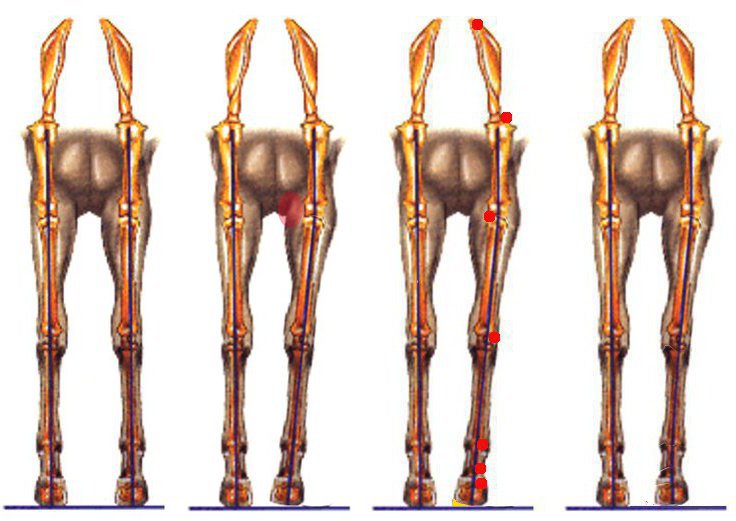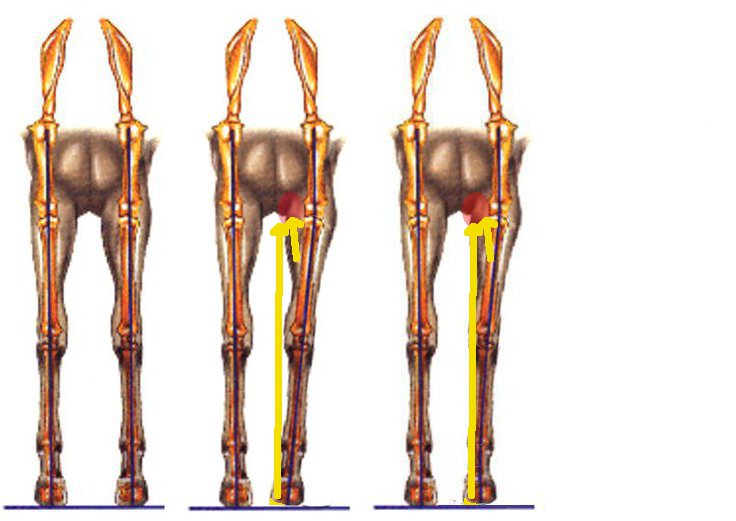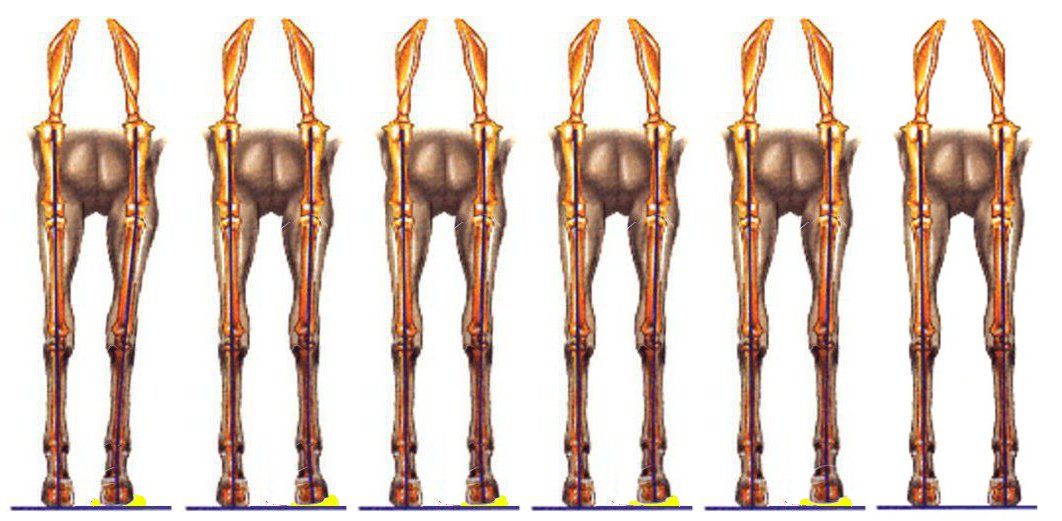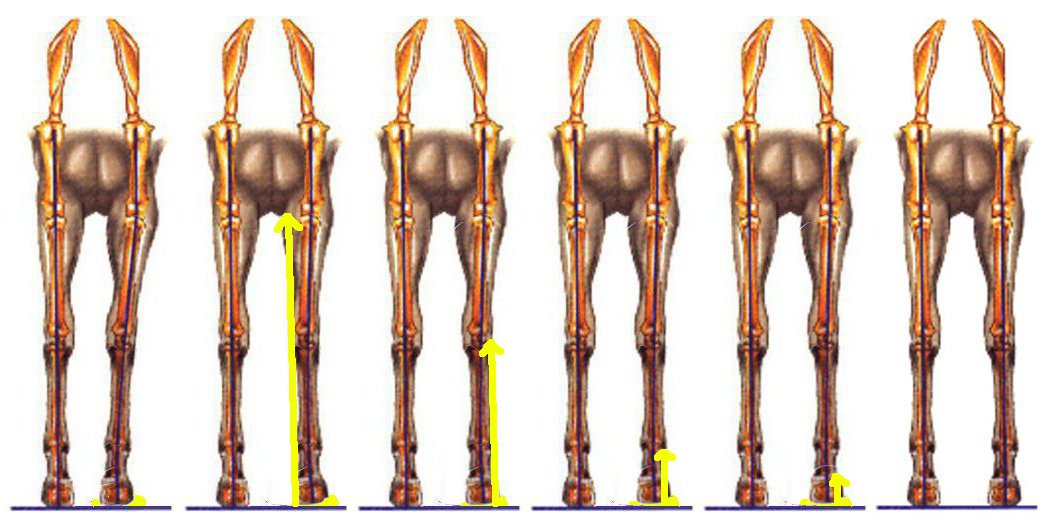Standing on Foam
how does that work?
If you've had an Equine Positional Release
appointment with me, or come to a workshop, you've heard me
say that it's all about teaching you techniques that you
can use at home when I'm not there.
Having your hose 'stand on foam' makes it super easy
to get the benefit of Equine Positional Release.
Here's why ~
Theory of Equine Positional Release and Ortho-bionomy
Equine Positional Release is based on the premise
that if a muscle is tight, it will release when it gets the
neurological. proprioceptive message that it no longer
needs to be tight.
The easiest way to send this message is to turn off
any messages that the muscle needs to be tight.
The easiest way to do that is to quit doing things
that make the muscle tight(er.) The easiest way to
accomplish this is to move the ends of the muscle towards
the tight spot.
Coincidentally, this also feels really
good! Why? Because the tight muscle is no
longer being stretched beyond what it can do and so it
quits feeling bad. This also turns off the 'alarm' in
the system that something is wrong. When the 'alarm'
is sounded - by stretching a tight place, it responds by
doing what it knows to do to protect the system. It
tightens even more. This is why stretching a muscle
with a muscle knot in it is counter productive at best and
possibly damaging.
What's going on with the Foam under the Foot
In an ideal world, where the horse has an ideal body,
it doesn't have overstressed, over tightened, knotted up
muscles and we also have an excellent farrier so the
horse's feet are ideally connecting with the ground.
When this is the case, the column of the leg is
positioned correctly under the horse and supports the horse
equally around the full 360 degrees of the column.
None of the muscle have to remain unduly contracted just to
keep the horse upright and functioning. They can
activate and release completely.
When there is a problem (and when isn't there?!) with
a habitually tight muscle or a foot that has been
inadvertently incorrectly trimmed or shod, the result is a misalignment in the
column. The foot no longer lands flat on the ground.
It's dangling in midair and the foot is unevenly supporting
the horse. Or, the horse is unevenly supported.
If you could measure the weight in the hoof wall, you would
find that certain areas of the hoof wall are 'heavier' and
pressing into the ground more than others. Some may not
even be making contact with the ground. This means
the muscles now have to compensate and work to support the
horse -- the structural integrity is not there to hold the
horse up, and so the muscles will do whatever they can to get
the column of the leg back under the horse.
Because they are busy doing that, they cannot fully
release. They also cannot properly contract. If
not remedied, there will be gait problems and pain problems
and maybe behavioral problems.
Nature will correct this by filling in the space with
hoof. (This is because there's nothing opposing the
hoof and it will not wear off until it makes contact with
the ground -- which is actually where it needs to get to in
order for the leg to return to normal!)
With the foam, the same principles are at work
and, better yet, it's quicker than waiting for the hoof to
grown and for us people, it takes the guess work out of what to do.
We don't have to worry about doing the wrong thing.
Filling in the empty space takes the stress off the
stressed muscle, allowing it to release. When the
muscle is not supported, it is being stretched beyond its
ability. This creates an alarm and the muscle
contracts more to protect itself, contributing to more
misalignment. (ACK!) When the hoof fills in or
the foam pad is placed under the foot, the column is
supported once again. The message the muscle gets is
that it is supported and can quit protecting via
tightening. This allows
the leg to return to its correct position.
Without support, the muscle is stretched beyond what
it can do and responds by guarding and
tightening. With support, the muscle doesn't
have to guard and can let go, with the result that the leg
returns to its correct position. This starts a chain
reaction of returning to normalcy.
As an Example
Let's say the horse is tight on the
inside of it's left foreleg. There's been a misstep
of some kind. This pulls the leg to
the medial line, puts weight on the lateral edges of the
hoof and the whole support column, and leaves the inside of
the hoof hanging in midair.
In the illustration, there's a bubble near the
original pulled muscle; the yellow under the hoof indicates
the unsupported foot; the red dots show where the joints
get crunched as a result. (provided there wasn't
another problem in there beforehand as well...)
If this is not attended to, the bones in column will
shift -- because the foot has to find the ground somehow
and until the hoof grows in, the only way for that to
happen is for the bones in the leg to readjust. They will
do their best to 'split the difference.' What has
been pulled to the inside and can't return to the outside
will stay to the inside, but everything else that can move
back to the outside will do its best to do that and get
back underneath where it belongs.
If this persists due to (obviously unintentional but
nevertheless) consistent re-injury and/or misguided
farriery interventions, you will end up with a horse with
crooked legs and oddly shaped feet.
If you're in this boat, cut yourself a lot of
slack! This wasn't where you were planning to be and
these types of things are usually very subtle when they
start out. There aren't big red flags. Horses
will hide problems as long as they can -- they don't want
to get eaten, so their job is to appear perfectly healthy
and fine. By the time they have to 'fess up, it may
be a bit over the top. AND -
There's a way out of this!
(note: yes, these are totally
doctored images that I'm using! And also yes, if this
is going on, you will have many other things going on as
well. This can turn into a chicken-and-egg
thing. But there's a way out of it.)
| Ideal |
Oops!
Pulled muscle on inside |
Hoof is left
hanging in the air! Injured muscle is unsupported
and guards by tightening, pulling leg even more to the
inside. Stress develops in the
column. |
Misalignment
over
time if there is unintentional but consistent re-injury and/or misguided
farriery. |
 |
If you have a horse at the 'oops!' stage or at the
'results' stage, the answer is the same - put something
under the medial side of the foot -- that space area I've
filled in with red, and make it just a smidge
higher.
A smidge higher is maybe .25cm.
1/8." 1/16." It's a smidge. Not
sure how much of a smidge to use? Foam pads to the
rescue!
The added benefit is that it will release one thing
and then the next thing and then the next thing, and so on,
and you don't have to move the foam pad or worry about the
height of anything.
Why does this work? The compression travels up
the leg into the area that was tight and releases it and
all the other tight places.

If you catch this right when it happens, the column
is still relatively straight and the leg simply swings back
out underneath the horse where it belongs.
If there's
a long standing problem, there are several areas of compensation
that will need to be released. The foam pad adjusts
in height, supporting the full column automatically as
releases occur. How cool is that? In my
illustration, I've shown the releases from the top down,
but this isn't necessarily how something like this would
occur in real life. The yellow areas show where the
lift is targeting the release. (And, yes, I made a
pretty picture at the end...)


How to do this
 
There are some kitchen floor mats available (like the
one pictured here) that are made of a high density foam that gives just a little bit
but also fills in the areas where it's not getting
squished. I've also recently seen play mats for
toddlers that would work. They used to have larger
ones with designs on them. I'm guessing an old set of
crocs you could cut up might work, too.
Double up the kitchen mat so it's maybe an inch
thick. Pick up one of the horse's feet and place the
mat on the ground. Get the horse to put its foot on
the foam. Encourage the horse to shift it's weight
onto that foot. If the horse is adamant about not
putting weight on a foot, respect that! (Also note:
if you can't get a foot off the ground, it's because it's
the good foot and taking it off the ground means the horses
is in fear of falling over.)
Releases that can occur will occur in less than a
minute. If you figure there are seven joints in a
leg, you might give it ten minutes per leg.
A long standing pattern will take more than one
session! Every day might be too much, though.
Figure a couple times/week is good. This way the rest
of the horse can adjust.
Generally, you will see greater and greater levels of
comfort and performance and better attitude over time.
When you get a knack for this, you can assist
releases in the neck and back as well.
It is seriously cool stuff!
So if you're not able to set up an Equine Positional
Release session, give the foam pads a shot.
If you try it, let me know how it goes! And if
you'd like some hands on, call me up for a session.
Part of every Equine Positional Release session involves how
to continue on with 'self-care' when I'm not around.
Cheers!
L
|




![Centered Riding Today: An Informal Talk by Sally Swift [VHS]](http://ecx.images-amazon.com/images/I/41Vn6PfhzML._SL125_.jpg)
![Centered Riding with Sally Swift [VHS]](http://ecx.images-amazon.com/images/I/51OSh9kd9iL._SL125_.jpg)








